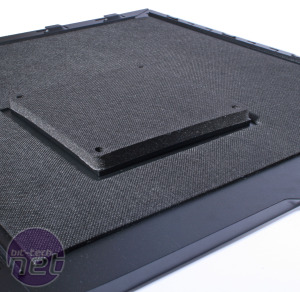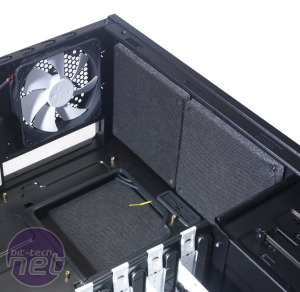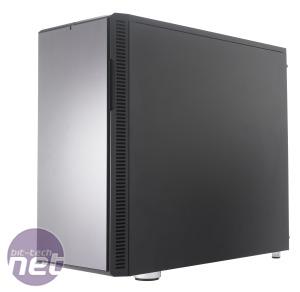
Fractal Design Define R3 Performance Analysis and Conclusion
The first thing to mention here is that we have revised our case testing kit since we reviewed the the R2 which means that results will not be directly comparable between it and the R3. The headline change in the kit is the addition of an actively cooled, rear exhausting graphics card which runs its fan at a constant 30%. This is by far and away the loudest component in the PC so we were eager to see how well the R3 controlled the noise the card produced.After an hour of running our punishing stress test the CPU delta T topped out at a mid table 51oC. This was 1 degree better than the similarly sized but much more porous HAF 912 and comfortably ahead of the more expensive Corsair Graphite 600T and BitFenix Colossus cases which is a great result for a case that prioritizes quietness over cooling.
Graphics card cooling was equally impressive given the nature of the case with a GPU delta T of 42oC. This puts the R3 on a par with one of our current favourite mid range midi tower case the Xigmatek Utgard and the distinctive NZXT Phantom, though admittedly this was with the two comparison cases running their fans at minimum speed.
Upon closer inspection it became clear that upping the fan speeds made a large difference to the R3 as significantly more air was being drawn in and expelled from the case than with the R2. It was also clear that the rear exhausting graphics card cooler of our test HD 5870 suited the R3 which is quite the contrast to the passively cooled card we used in our old case test kit.
This is because the fan mount blanking plates of the R3 effectively turn the case into a closed system with hot air only being expelled by the rear exhaust fan. This is fine if it’s only got the heat from a CPU to contend with but becomes an issue if you add the heat from a graphics card to the mix too. As a result we’d recommend anyone thinking of housing their PC in a R3 make sure their graphics card cooler exhausts air out the back of the case rather than into the case.
Obviously we were also interested in how well the R3 stacked up against the competition in terms of noise levels and we’re pleased to say that, much like its predecessor, this is an area in which the case excels. The high drone of the graphics card cooler was noticeably reduced by the R3 chassis; most of the noise that did escape was actually through the vented back plate of the graphics card cooler itself. The case fans did output a slightly more audible low level rumble than their slower R2 based brothers but this was barely noticeable unless we put our ear right up to the case.
Conclusion
The Fractal Design Define R3 builds on the successes of the Define R2 and improves on it in many areas. The case feels more solid and sturdy and the noise dampening materials used thought the case are much improved in both appearance and construction.The cooling that the case provides is also improved with Fractal making the sensible decision simply to improve the fans already present in the R2 rather than adding more of them. We actually think the level of cooling offered by the R3 is excellent when you consider the cases size, number of fans and lack of open grilles or fan mounts for heat to escape from.
It’s not for everyone though and if you’re looking to build a overclocking behemoth or a multi GPU gaming daemon then you’d best look elsewhere. If however you’re looking to make a quiet, stylish PC then we can’t think of a better case to do it in.
- Cooling
- x
- x
- x
- x
- x
- x
- x
- -
- -
- -
- 7/10
- Features
- x
- x
- x
- x
- x
- x
- x
- x
- x
- -
- 9/10
- Design
- x
- x
- x
- x
- x
- x
- x
- x
- x
- -
- 9/10
- Value
- x
- x
- x
- x
- x
- x
- x
- x
- -
- -
- 8/10
- Overall
- x
- x
- x
- x
- x
- x
- x
- x
- x
- -
- 9/10

Fractal Design Define R3

MSI MPG Velox 100R Chassis Review
October 14 2021 | 15:04












Want to comment? Please log in.